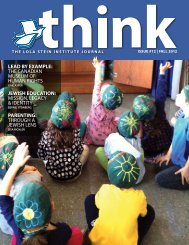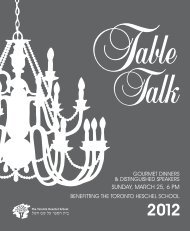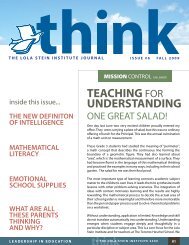Issue No. 13 - The Toronto Heschel School
Issue No. 13 - The Toronto Heschel School
Issue No. 13 - The Toronto Heschel School
You also want an ePaper? Increase the reach of your titles
YUMPU automatically turns print PDFs into web optimized ePapers that Google loves.
AWE & WONDER<br />
routines – sitting a certain way, writing the date a certain way, and<br />
so on. Some students thrive in this kind of structure, but others find<br />
it oppressive and unnecessary. For some, ritual means certainty, for<br />
others it seems to conflict with freedom and authenticity: Why do<br />
you have to say please and thank you if you don’t feel grateful? Why<br />
would you say blessings over food before and after eating if you’re<br />
not sure that you “believe in” God. (As if belief is a matter of being<br />
sure!)<br />
<strong>The</strong>re is an aspect to ritual that is not only about structure and<br />
regulation. <strong>The</strong> text concerning the twice-daily sacrifice of a lamb<br />
is also a metaphor for something else: it is a metaphor for making<br />
an offering. In ancient Israel, animal sacrifice was used to make an<br />
offering to God as a sign of gratitude or to seek forgiveness for a<br />
misdeed. In other words, ritual sacrifice was a way to strengthen,<br />
maintain, or restore a relationship with the Divine.<br />
a particular ethical action (middah), which can be derived from<br />
the weekly Torah portion. Students review the middah with their<br />
teacher each morning and discuss ways to implement it. As part<br />
of their Shabbat preparation at week’s end, the students reflect<br />
together on how well and in which ways they have practised the<br />
middah over the course of the week.<br />
As educators and parents, we know that children benefit<br />
from daily ritual.<br />
<strong>The</strong> school also guides students in practising other rituals during<br />
their day; for example, performing netillat yadayim (the ritual<br />
handwashing prior to meals) and reciting birkat hamazon (the<br />
blessing after meals). <strong>The</strong> school requires that each day the students<br />
take time to care and clean their classroom and the common<br />
lunchroom.<br />
RITUAL<br />
FOR OUR TIME<br />
By Greg Beiles<br />
Jewish tradition recounts a debate among the ancient rabbis over<br />
which biblical passage might encapsulate the whole teaching<br />
of the Torah. 1 One rabbi states that the verse announcing the<br />
unity of God – “Listen, O Israel, the Lord is our God, the Lord is<br />
One” – contains the whole Torah. A second rabbi responds that<br />
the ethical verse “You will love your neighbour as yourself” is<br />
the preeminent verse. A third rabbi declares “You will sacrifice a<br />
lamb in the morning and another after dusk” and claims this as<br />
the quintessential verse of the Torah.<br />
…anyone who reads biblical laws concerning oxen<br />
and thinks that an ox is just an ox, is himself an ox.<br />
To the contemporary ear, the first two positions sound reasonable:<br />
the idea of monotheism, of a unifying force in the universe seems<br />
like a pretty significant concept, worthy of representing the<br />
whole Torah. Likewise, the ethical principle of the Golden Rule<br />
resonates with us. But the third position, the suggestion that the<br />
whole Torah can be discerned in the principle of daily animal<br />
sacrifice, seems outdated and, to some, even ethically offensive.<br />
Why, then, does the master of the rabbis conclude that, in fact,<br />
the law is in accordance with this third position?<br />
Self-Portrait with Pogo by Lindee Climo ©2012 Lindee Climo. Mira Godard Gallery<br />
We must first avoid the easy temptation to disregard the ruling as an<br />
anachronism and no longer relevant: “Animal sacrifice? We don’t do<br />
that anymore. Loving our neighbours as ourselves – well that’s a more<br />
modern idea.” Better, would be to regard this ruling as a metaphor.<br />
As the Talmudic scholar Adin Steinsaltz wittily remarked, anyone who<br />
reads biblical laws concerning oxen and thinks that an ox is just an ox<br />
is himself an ox. 2 Clearly, the sacrifice of an ox or, in this case, a lamb is<br />
a metaphor; but a metaphor for what? And how does this metaphor<br />
help us as educators?<br />
At one level, it is a metaphor that speaks to the importance of daily<br />
ritual. As educators and parents, we know that children benefit both<br />
cognitively and emotionally from daily ritual. Daily ritual provides<br />
children, especially young children, with a sense of stability and<br />
comfort. It allows them to anticipate the day, and to appreciate<br />
patterns in their everyday routines. And this, in turn, aids creativity and<br />
insight. It is on the canvas woven by regularity that children feel safe<br />
and confident enough to take creative risks. Against a background of<br />
patterns, it becomes possible to notice irregularities and to innovate.<br />
And yet, modern people and modern educators are often suspicious of<br />
ritual. To be sure, ritual sometimes serves merely as a way of maintaining<br />
control. We have all met teachers who insist on certain classroom<br />
Students perform daily chores in the classroom and<br />
common lunchroom… As these rituals became an<br />
embedded part of daily practice, we noticed a palpable<br />
change in lunchroom culture – a quieter, calmer, more<br />
respectful environment.<br />
Today, human beings use rituals in an analogous way. We have set<br />
practices, customs, and habits that we hold on to and observe with<br />
respect. <strong>The</strong> ritual of giving gifts on special occasions, of offering<br />
kind and polite words, of holding the door for someone to enter, of<br />
apologizing for error – all of these are rituals that initiate, maintain,<br />
strengthen, or restore relationships.<br />
When the master rabbi affirmed the primacy of the twice-daily<br />
sacrifice, his decision acknowledged both dimensions of ritual:<br />
its regularity and its power to build relationships. By emphasizing<br />
regularity as well as relationship, the rabbi taught that ritual not<br />
only expresses the relationships we already have – with people or<br />
with God – but also, when done on a regular basis, ritual actually<br />
produces these relationships! We hold the door open not only for<br />
our friends but also as a gesture that opens up the possibility to<br />
engender new friendships.<br />
This becomes much clearer when we look at how the<br />
aforementioned debate among the rabbis is structured. <strong>The</strong> unity<br />
of God, which is to say, the recognition of the sanctity of all God’s<br />
creation is the ultimate goal. A key way to achieve this goal is to<br />
recognize the sanctity of each person – to treat each person as<br />
oneself. But the method or way to actually do this practically is<br />
through daily rituals of offerings – whether by word or deed. <strong>The</strong><br />
rabbi established the primacy of ritual as the “law,” because the law,<br />
like ritual, teaches us how to act and behave despite how we may<br />
feel.<br />
<strong>The</strong> Jewish philosopher Emmanuel Levinas summarizes this<br />
understanding of the rabbis’ debate:<br />
<strong>The</strong> way that leads to God, therefore leads to man [i.e., humanity];<br />
and the way that leads to man draws us back to ritual discipline and<br />
self-education. Its greatness lies in its daily regularity. 3<br />
Several years ago <strong>Toronto</strong> <strong>Heschel</strong> <strong>School</strong> initiated a school-wide<br />
ritual practice called Middat Hashavuah – the “weekly ethical<br />
practice.” Each week, students and staff focus on implementing<br />
Despite resistance from some students contending that they “don’t<br />
believe” in a particular ritual, and from some parents who argue<br />
that they don’t pay tuition to have students wipe down tables,<br />
<strong>Heschel</strong> teachers have worked hard to maintain these rituals,<br />
primarily through role-modelling. As these rituals have become<br />
an embedded part of our school’s daily practice, we have noticed<br />
a palpable change in our lunchroom culture – it has become a<br />
quieter, calmer, more respectful environment. Ritual helps to create<br />
the culture that effectively builds community.<br />
Ritual is the main theme of the third book of the Torah, Sefer Vayikra<br />
(Leviticus). I have always considered Sefer Vayikra to be the “heart”<br />
of the Torah, not only because of its position as the third of the five<br />
books of the Torah but especially because of its significance as a<br />
spiritual-ethical guide. Most progressive Jewish schools tend to skip<br />
over the lengthy portions of Sefer Vayikra that deal with the details<br />
of animal sacrifice and other ritual affairs. Instead, they focus only on<br />
chapter 19, the famous “Holiness Code,” which contains such ethical<br />
gems as “love your neighbour as yourself.” At <strong>The</strong> <strong>Toronto</strong> <strong>Heschel</strong><br />
<strong>School</strong>, we believe that, in order to appreciate the ethical messages<br />
of the Holiness Code, students must study the chapters concerning<br />
animal sacrifice, kashrut, and other ritual practices. <strong>The</strong>se chapters<br />
remind us that the most beautiful ethical imperatives will fail us<br />
unless we appreciate and regularly practise the self-discipline and<br />
generosity that rituals teach.<br />
1 A traditional midrash cited by Rabbi Ya’akov ibn Chaviv in the Introduction, Ein Ya’akov.<br />
2 Cited in Raphael Ahren, “Never Mind the Bible, It’s the Sanity of the Talmud You Need to<br />
Understand the World and Yourself,” Times of Israel, August 9, 2012.<br />
3 Emmanuel Levinas, “A Religion for Adults,” in Difficult Freedom: Essays on Judaism (Delaware: <strong>The</strong><br />
John Hopkins UP, 1990), p. 19.<br />
Greg Beiles, M.A., is the Director of <strong>The</strong> Lola Stein Institute,<br />
and Curriculum and Training Consultant for <strong>The</strong> <strong>Toronto</strong> <strong>Heschel</strong><br />
<strong>School</strong>. Greg targets high academic standards through a culture<br />
of learning that integrates Torah, arts, science, and ethical<br />
awareness and strengthens children’s cognitive, emotional, and<br />
spiritual capacities.<br />
04 think • issue <strong>13</strong> • SUMMER 20<strong>13</strong><br />
05






